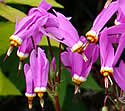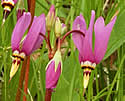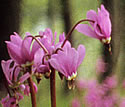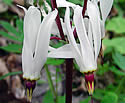Dodecatheon amethystinum (Jeweled Shooting Star)
| Also known as: | Amethyst Shooting Star |
|---|---|
| Genus: | Dodecatheon |
| Family: | Primulaceae (Primrose) |
| Life cycle: | perennial |
| Origin: | native |
| Habitat: | part shade, sun; moist north-facing slopes, limestone cliffs in hardwood forests |
| Bloom season: | April - May |
| Plant height: | 4 to 18 inches |
| Wetland Indicator Status: | none |
| MN county distribution (click map to enlarge): |  |
| National distribution (click map to enlarge): |  |
Pick an image for a larger view. See the glossary for icon descriptions.
Detailed Information
Flower: 
![[photo of flowers]](/udata/r9ndp23q/pd/dodecatheon-amethystinum-2798-t.jpg) A single cluster of up to 10 (rarely more) nodding, long-stalked, rose-purple to pink blossoms (rarely white) at the tip of a smooth, slender stem. Petals are fused at the base into a downward facing tube with a wavy ring of maroon, yellow and white around the base. 5 rounded oblong lobes, 1/3 to ¾ inch long, are folded tightly back against the tube and are sometimes a bit twisted. Slender, yellowish stamens are tightly pressed against a single, long purplish style projecting from the center. The arching stalk of each flower has long, glandular hairs near the the flower. Flowers become erect after pollination.
A single cluster of up to 10 (rarely more) nodding, long-stalked, rose-purple to pink blossoms (rarely white) at the tip of a smooth, slender stem. Petals are fused at the base into a downward facing tube with a wavy ring of maroon, yellow and white around the base. 5 rounded oblong lobes, 1/3 to ¾ inch long, are folded tightly back against the tube and are sometimes a bit twisted. Slender, yellowish stamens are tightly pressed against a single, long purplish style projecting from the center. The arching stalk of each flower has long, glandular hairs near the the flower. Flowers become erect after pollination.
Leaves and stems: 

![[photo of leaves]](/udata/r9ndp23q/pd/dodecatheon-amethystinum-15-t.jpg) Leaves are all basal, oval-elliptic to lance-oblong, 1½ to 9½ inches long, ½ to 3 inches wide, hairless and toothless, rounded at the tip and tapering to a short winged stalk. The leaf base may be tinged red. Flowering stems are multiple from the base, hairless and green to purple.
Leaves are all basal, oval-elliptic to lance-oblong, 1½ to 9½ inches long, ½ to 3 inches wide, hairless and toothless, rounded at the tip and tapering to a short winged stalk. The leaf base may be tinged red. Flowering stems are multiple from the base, hairless and green to purple.
Fruit: 
![[photo of mature fruit]](/udata/r9ndp23q/pd/dodecatheon-amethystinum-fruit-14-1-t.jpg) Fruit is an erect, oval to cylindric capsule ¼ to 2/3 inch long, the five lance-shaped calyx lobes around the base and the slender style still attached at the tip but eventually disintegrating. The capsule is thin-walled and dries to a light yellowish to reddish brown.
Fruit is an erect, oval to cylindric capsule ¼ to 2/3 inch long, the five lance-shaped calyx lobes around the base and the slender style still attached at the tip but eventually disintegrating. The capsule is thin-walled and dries to a light yellowish to reddish brown.
Notes:
Jeweled Shooting Star's North American range is severely restricted to the limestone hills and valleys of the mid-west driftless region, with a disjunct population in the Appalachians. Very little distinguishes it visually from the more common and widespread (in its North American range) Prairie Shooting Star (D. meadia), which is found in drier wooded and open prairie habitats, blooms two weeks earlier, has thick-walled seed capsules that dry to dark reddish brown, and is typically white to less frequently pink or lilac. Some references make note of reddish (or not) leaf bases being a distinguishing characteristic but we have not found that to be reliable in the field—habitat and ripe fruit are the more consistent differences. Also similar is D. pulchellum, a western species not found in Minnesota. In Minnesota D. amethystinum, known as Primula fassettii in some references, is a tracked species while, D. meadia is listed as endangered. Both perform handsomely in a home garden setting.
Native Plant Nurseries, Restoration and Landscaping Services ↓
More photos
 garden-grown Jeweled Shooting Star plant
garden-grown Jeweled Shooting Star plant Jeweled Shooting Star habitat
Jeweled Shooting Star habitat Jeweled Shooting Star habitat
Jeweled Shooting Star habitat Jeweled Shooting Star habitat
Jeweled Shooting Star habitat white-flowered variant
white-flowered variant developing fruit
developing fruit
Photos courtesy Peter M. Dziuk taken in Fillmore and Goodhue counties, and a private garden in Anoka County. Photos courtesy Joe Fierst taken at Zumbro Valley SNA. Photos courtesy Beth Gauper and Torsten Muller taken at Perrot State Park, Wisconsin.
Comments
Have you seen this plant in Minnesota, or have any other comments about it?
on: 2014-06-01 12:50:48
Flowers were up on the peak of the north facing slope above the Zumbro river on May 25th. I've been calling this Meadia. White variety up as well but only in a small section further east along the next bluff.
on: 2015-05-11 08:22:13
May 6th (Mother's Day), 2015 flowers blooming on the peak of the shaded, south facing slope among outcroppings of rocks. Above Beaver Creek. Perhaps a dozen plants in small area.
on: 2015-05-14 12:30:53
May 14th - blossoms along a forested trail on the campus of Saint Mary's. Not certain if it's Dodecatheon meadia or amethystinum, but likely the latter based on the description and habitat. The former is sometimes found on the goat prairies.
on: 2015-07-08 14:24:38
Early May 2015, located and mapped 55 in-bloom plants in this protected remnant. I suspect these are meadia. Just as the seed heads reached the "milk" phase, every single head was browsed off by deer within a few days. Similar thing happened last year also. Are our artificially high deer populations contributing to declines of select native plants?
on: 2015-07-10 18:08:05
Mark, deer are killers of wildflowers. The over-population does indeed have a negative effect on plant communities.
on: 2016-04-22 23:29:24
On a long rock out cropping on an east facing bluff. there are thousands of them. a rare and beautiful sight.
on: 2016-04-27 21:36:10
22-4-2016 - Noted very early bloominstages of jeweled shooting star. Found many beds of immature shooting star on the north facing bluffs along the river. With early signs of bloom. I expect them to peak within the next two weeks, and if you have the chance to see them you very much should.
on: 2017-05-14 16:10:11
On May 14, 2017, I found one plant slightly past peak bloom on the forested north slope of the ridge that forms the north side of the central valley of the SNA. Two vigorous plants high up on the west end of the ridge (outcrop in sun) were slightly past prime (from zoomed photos). A colony on the south-facing side of the ridge (rocky bluff prairie, full sun) was mostly already forming seed capsules.
on: 2020-05-06 19:28:44
May 6th, 2020, starting to bloom on Choice WMA in Preble Township.
on: 2020-09-20 02:02:54
My son gave me a shooting star plant in mid June that he bought at a garden center. I planted it at the base of a dead elm tree. It completely disappeared after a short time. Is this normal? Will it come back in the spring? I know what the growing conditions are for a shooting star because I have some growing on a rocky, sandy but rich soil area in my woods in SE Winona county.
on: 2022-06-14 17:18:39
Huge stands of these on the East side of the Zumbro River blooming May 8, 2021.
on: 2023-02-03 08:58:44
The native plant trade, proper ID, and photos appears more troublesome the more I look. I purchased plugs of what were labeled as D. meadia. They flowered after 2nd season and were all an intensely magenta color and did fine in savanna like setting. But I wondered about that color, despite known variability. On prairie moon's site, I see Dodecatheon pulchellum listed -a western mountain species, but with your picture seen here, under D. amethystinum. Since some of these species are difficult to ID for the lay person, and why we find ourselves here -sigh, the trades compound confusion from time to time. I will need to photograph my "meadia" closely this spring and properly ID them.






